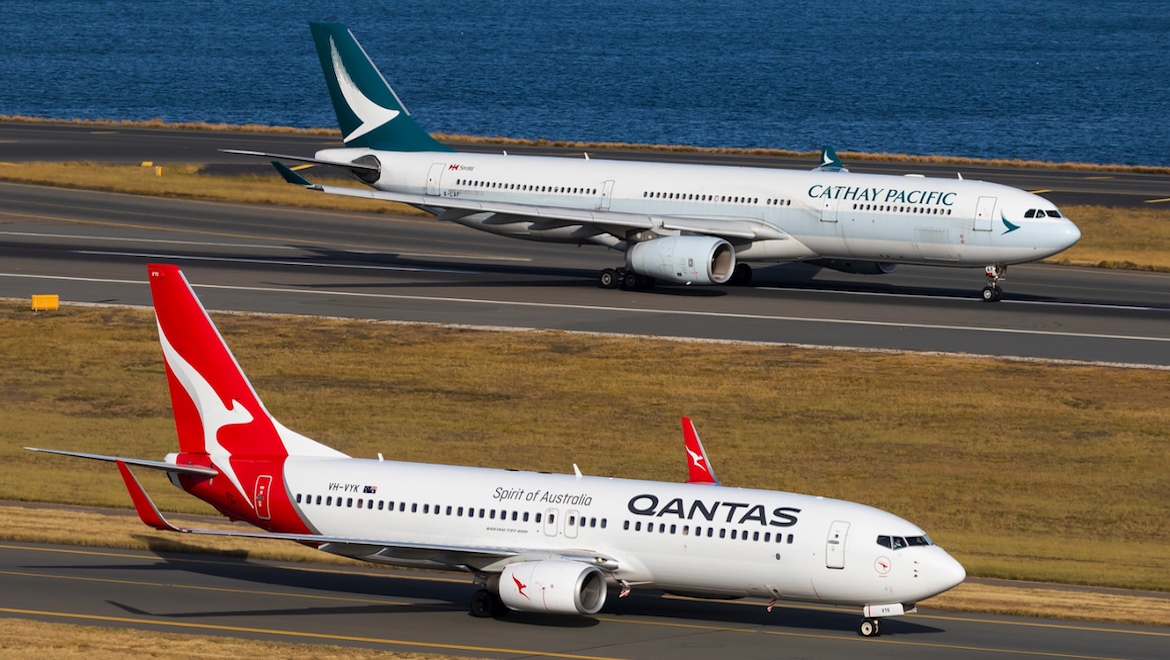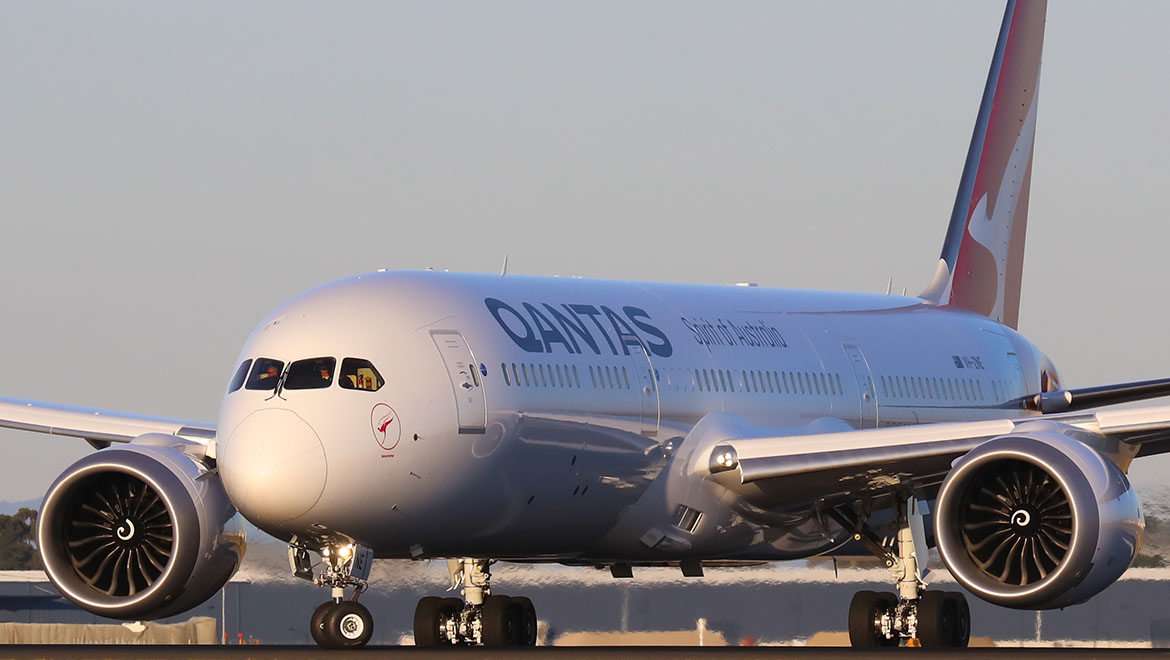
Qantas has called on regulators to allow its proposed codeshare with Cathay Pacific to go ahead subject to a period of review to determine if any of the “hypothetical concerns” identified in a draft decision rejecting the application do eventuate.
The Australian carrier has written to Australia’s International Air Transport Commission (IASC) calling for the draft decision denying authorisation for Cathay Pacific to add its CX airline code on 35 Qantas-operated flights a week from Brisbane, Melbourne and Sydney to Hong Kong.
These codeshare flights would only be sold as part of a through journey involving connections either beyond Hong Kong on Cathay Pacific or its regional wing Cathay Dragon to destinations in India, Sri Lanka and Vietnam, among other countries, or to other Australian domestic destinations from Brisbane, Melbourne and Sydney on Qantas.
The IASC, which manages Australia’s traffic rights, said in the draft decision published on May 24 the proposed codeshare was likely to “entrench and expand the market position” of the two airlines to the detriment of Virgin Australia’s competitive position and the position of any potential future entrants on the route.
Qantas’s submission dated June 14 and published on the IASC website said the Commission had reached “inappropriate conclusions” about the competitive effects the proposed codeshare would have on the market.
In further criticism, it said IASC’s assessment had “substantive flaws”.
“A re-examination of the proposed codeshare’s impact on competition relative to an appropriate counterfactual is warranted,” the Qantas submission said.
“The Commission’s view that the proposed codeshare will lead to anti-competitive effects, such as ‘increases to airfares’ on point to point routes ignores the competitive realities of this competitive market.”

Qantas had argued previously the codeshare agreement was a pro-competitive move designed to offer passengers more choice on a greater number of city pairs and would have no adverse impact on the competitive dynamics on point-to-point routes between Australia and Hong Kong.
Its June 14 submission to the IASC reiterated this point, describing Virgin Australia as an effective and vigorous competitor on the Australia-Hong Kong route.
Meanwhile, competition from third-country carriers on routes between Australia and markets covered under the proposed codeshare was extensive, Qantas said, noting Cathay Pacific and Qantas’s combined market share on services between Australia and India was less that that of Singapore Airlines.
“The Commission has given too much weight to hypothetical possibilities that favour declining approval,” Qantas said.
“In Qantas’s view, the draft decision neglects to give propose weight to the fact that the proposed codeshare would immediately deliver real and tangible consumer benefits through increased schedule choice, reduced connection times and frequent flyer benefits.”
In its submission to the IASC, Virgin Australia rejected Qantas’s assertion there would be no adverse impact on the competitive dynamics on point-to-point routes between Australia and Hong Kong.
Instead, giving Cathay Pacific the ability to sell Qantas-operated flights under the codeshare agreement – even if it was only for connecting itineraries – was likely to lead to higher passenger load factors on Qantas’s flights between Australia and Hong Kong.
This would give Qantas a greater ability to adopt different strategies on pricing and inventory management and result in a potentially significant detrimental impact on competition, Virgin Australia said.

Proposed codeshare would have built upon existing partnership that began in October
Cathay Pacific and Qantas began codesharing on some of each other’s flights in October 2018, with had Cathay Pacific adding its CX airline code on 13 Australian domestic routes operated by Qantas.
Meanwhile, Qantas added its QF airline code on two Australia-Hong Kong routes (Cairns and Perth to Hong Kong) and 10 routes from Hong Kong to India, Myanmar, Sri Lanka and Vietnam operated by Cathay Pacific. Cairns-Hong Kong is ending in October.
Then, in early January 2019, Qantas applied to the IASC to expand the agreement to allow Cathay Pacific and Qantas to codeshare on each other’s flights between Australia to Hong Kong when sold as part of a connecting journey.
The partnership also covered Qantas placing its QF airline code on 35 Cathay Pacific-operated flights a week on the same routes from Brisbane, Melbourne and Sydney to Hong Kong. However, this did not require IASC approval.
Qantas told the IASC in its June 14 submission the existing arrangements were under review following the draft decision.
“The Commission has not appreciated that Cathay is already disincentivised to continue to allow Qantas the benefit of being able to sell additional routes and flights on its services if Qantas cannot – by virtue of regulatory inflexibility – reciprocate this ability for Cathay,” Qantas said.
Finally, Qantas said the IASC should “err on the side of permitting and monitoring” the proposed codeshare, noting the Commission had the ability to review the arrangements at any time.
Further, it said giving the deal the green light would be “wholly consistent” with the objectives of the relevant legislation and the policy statement.
“Approving the application to enable the proposed codeshare to be implemented, with a commitment to monotony, reviewing or potentially revoking any variation if public benefits failed to be delivered in due course, would be a far more appropriate exercise of the statutory powers conferred on the commission,” Qantas said.
Qantas’s submission followed Cathay Pacific calling on the IASC to reverse course.
The codeshare flights are shown in bold in the table below:
Flight Number/Routing |
Qantas flights |
Cathay Pacific flights |
|
Brisbane-Hong Kong |
QF97 10:10–17:25 |
CX156 00:55 – 07:30 |
|
Hong Kong-Brisbane |
QF98 20:15 – 07:00+1 |
CX157 13:10 – 23:35 |
|
Melbourne-Hong Kong |
QF29 09:40 – 17:20 |
CX134 07:30 – 15:05 |
|
Hong Kong-Melbourne |
QF30 20:10 – 07:35+1 |
CX105 00:10 – 11:10 |
|
Sydney-Hong Kong |
QF127 10:20 – 18:00 |
CX110 07:35 – 15:20 |
|
Hong Kong-Sydney |
QF128 19:30 – 06:55+1 |
CX139 09:10 – 20:20 |
Qantas plans April 2020 launch of Brisbane-Chicago flights
In other Qantas news, the airline said on Monday it planned to begin nonstop flights between Brisbane and Chicago in April 2020 once the proposed alliance with American Airlines has received final approval from the United States government.
The four times weekly flights would operated by Boeing 787-9 equipment.
Qantas has previously flagged Brisbane-Chicago as one of the new routes to be added should the US Department of Transportation (DOT) approve the proposed joint-venture. The DOT has given tentative approval to the tie-up.
Chicago would add 30 additional unique one-stop destinations from Australia, Qantas said, with beyond connections on American Airlines.
Finally, Qantas said one of its six new 787-9s on order would be named Longreach in a nod to the soon-to-be retired Boeing 747-400ER fleet, which all feature the outback Queensland city on the fuselage.
















Patrick
says:I agree with Qantas on this. Virgin Australia is not going to go under on this, and they have plenty of money to get B787s, A330 NEOs, A350s, or A321LRs to make the point to point journey. They’re just too slow to innovate.
Scott
says:I disagree totally with Qantas on this, 90% market share is a grossly out of balance. To say it’s fine for Virgin to compete on a 100% open market, with Qantas and Cathay Pacific combined market share of 90%, whilst disregarding the fact BOTH these carriers were allowed to ESTABOLISH themselves for DECADES under a closed market and one fully Government owned is a false comparison and argument.
The AA/QF on US seems responsible to me even though they hold greater than 50% market share, VA/DL and ANZ/UA balances out fairly evenly, but how anyone can champion for a 93% market share request QF / CP as being fair / reasonable / required/ positive is beyond me and that’s the way the regulator ruled.
What wasn’t this deal needed before VA started on HK routes?, that’s the real question that needs answering.
Stu Bee
says:Poor old VA, they are sounding like a bunch of millennials. Guess what? The world isn’t fair so why should the aviation business be any different. Does VA want to go back to the Two Airlines Agreement days?